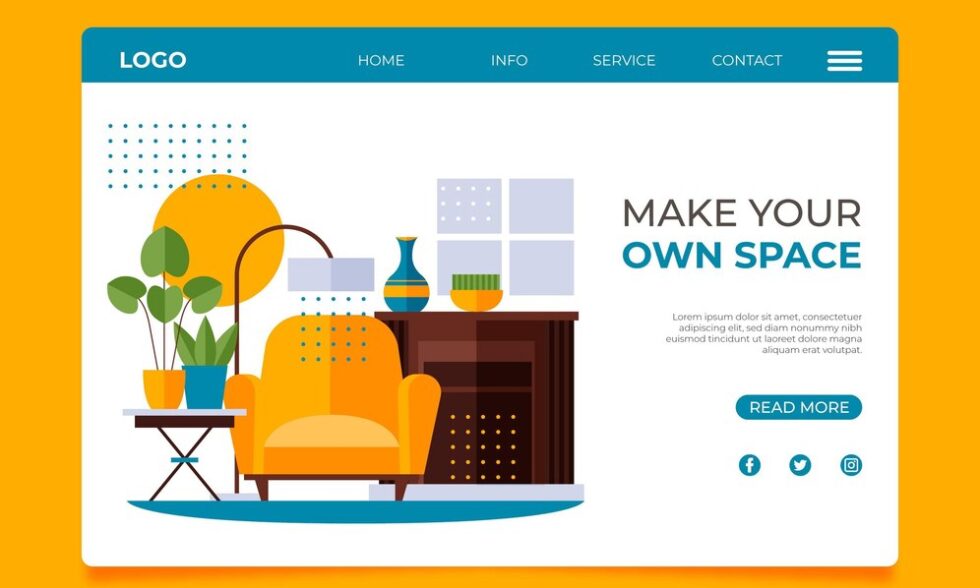In today’s digital age, having a home furniture website is not just an option—it’s a necessity. Your website serves as the virtual storefront where customers explore your products, get inspired by home decor ideas, and ultimately make purchasing decisions. But what makes a home furniture website successful? It’s not just about uploading product images and prices. A successful website requires careful planning, thoughtful design, and strategic execution to create an engaging experience that drives sales.
Understanding the Target Audience
Before diving into the development process, it’s crucial to understand who your target audience is. Are you catering to young professionals looking for modern and minimalist designs, or are your products more suited for families seeking comfort and durability? Understanding your audience’s needs, preferences, and buying behavior will help you tailor the website to meet their expectations.
Identifying Your Target Customers
Start by defining your target market. Consider factors such as age, income level, location, and lifestyle. For example, urban professionals may prefer sleek, contemporary furniture, while suburban families might prioritize functionality and comfort.
Understanding Customer Needs and Preferences
Once you’ve identified your target customers, delve deeper into their preferences. What are they looking for in home furniture? Is it style, durability, or affordability? Understanding these preferences will guide the design and content strategy of your website.
Tailoring the Website Experience to Your Audience
With a clear understanding of your audience, you can tailor the website’s layout, design, and content to create a personalized experience. For example, if your audience values sustainability, highlight eco-friendly products and sustainable practices.
Essential Features of a Home Furniture Website
A home furniture website must have certain features to ensure a seamless shopping experience. These features not only enhance user experience but also encourage conversions.
User-Friendly Navigation
Your website should be easy to navigate, with clear categories and filters that help users find what they’re looking for. A cluttered or confusing menu can frustrate users and lead to high bounce rates.
High-Quality Visuals
Furniture is a visual product, and high-quality images are essential. Provide multiple angles, zoom features, and lifestyle images that show the furniture in a home setting. Videos can also be a powerful tool to showcase the functionality and details of your products.
Product Descriptions and Details
Detailed product descriptions are crucial. Include dimensions, materials, color options, and care instructions. The more information you provide, the more confident customers will feel about making a purchase.
Customer Reviews and Testimonials
Social proof is powerful. Include customer reviews and testimonials to build trust and provide reassurance to potential buyers. Highlight positive feedback and address any concerns to demonstrate your commitment to customer satisfaction.
Wishlist and Shopping Cart Functionality
Allow customers to save their favorite products with a wishlist feature. Ensure that the shopping cart is easy to access and manage, with a clear and simple checkout process.
Designing the Website
The design of your website plays a significant role in how customers perceive your brand. A well-designed website not only attracts visitors but also keeps them engaged and encourages them to explore more.
Choosing the Right Theme or Template
The theme or template you choose should align with your brand identity. Whether you opt for a minimalist design or something more vibrant and eclectic, ensure that it reflects the essence of your brand.
Importance of Responsive Design
With more people shopping on their mobile devices, responsive design is non-negotiable. Your website should look and function seamlessly on desktops, tablets, and smartphones.
Color Schemes and Aesthetics
Color psychology plays a role in influencing purchasing decisions. Choose a color scheme that evokes the right emotions and complements your brand’s personality. For example, neutral tones can convey sophistication, while bold colors can add a sense of energy and creativity.
Layout and Structure
The layout of your website should be intuitive, with a logical flow that guides users through the site. Use whitespace effectively to avoid clutter and keep the focus on your products.
Content Strategy
Content is king, especially in the digital space. Your content strategy should focus on engaging your audience, providing valuable information, and optimizing for search engines.
Importance of Engaging Content
Engaging content keeps visitors on your site longer and encourages them to explore more. Consider creating a blog with home decor tips, furniture buying guides, and DIY projects to provide value to your customers.
Types of Content to Include
In addition to product pages, include a variety of content such as blogs, videos, and downloadable guides. This content not only provides value but also helps with SEO.
Using Storytelling to Connect with Customers
Storytelling is a powerful tool in marketing. Share the story behind your brand, the inspiration for your collections, and customer success stories. This personal touch can help build a connection with your audience.
Optimizing Content for SEO
SEO is crucial for driving traffic to your website. Use relevant keywords, optimize meta tags, and ensure your content is informative and valuable to improve your search engine rankings.
SEO Best Practices
SEO is not just about keywords; it’s about creating a user-friendly website that search engines can easily crawl and index.
Keyword Research for the Home Furniture Niche
Conduct thorough keyword research to identify the terms your target audience is searching for. Use these keywords strategically in your content, titles, and meta descriptions.
On-Page SEO Techniques
On-page SEO involves optimizing individual pages for search engines. This includes using keyword-rich titles, meta descriptions, header tags, and alt text for images.
Off-Page SEO Strategies
Off-page SEO refers to actions taken outside of your website to improve its ranking. This includes building backlinks, social media marketing, and influencer collaborations.
Local SEO for Furniture Stores
If you have a physical store, local SEO is essential. Optimize your Google My Business profile, use location-based keywords, and encourage customer reviews to improve your local search visibility.
E-commerce Integration
Your website’s e-commerce functionality should be seamless and secure, providing a smooth shopping experience for your customers.
Choosing the Right E-commerce Platform
Choose an e-commerce platform that meets your business needs. Popular options include Shopify, WooCommerce, and Magento. Consider factors such as ease of use, scalability, and customization options.
Payment Gateway Options
Offer multiple payment options to cater to different customer preferences. Ensure that your payment gateway is secure and reliable, providing a smooth checkout process.
Shipping and Return Policies
Clearly outline your shipping and return policies to set customer expectations. Offer multiple shipping options, including expedited shipping, and provide a hassle-free return process.
Security Considerations for Online Transactions
Security is paramount in e-commerce. Implement SSL certificates, use secure payment gateways, and regularly update your site’s security features to protect customer data.
Mobile Optimization
With the increasing use of mobile devices for online shopping, mobile optimization is essential for providing a good user experience.
The Importance of Mobile-Friendly Design
A mobile-friendly design ensures that your website is accessible and easy to navigate on smartphones and tablets. Google also prioritizes mobile-friendly websites in search rankings.
Tips for Optimizing Mobile User Experience
Simplify your design for mobile users. Use larger fonts, touch-friendly buttons, and streamline the navigation to make it easy for users to browse and shop on their mobile devices.
Testing Your Website on Various Devices
Test your website on various devices and screen sizes to ensure it works well across the board. Tools like Google’s Mobile-Friendly Test can help you identify and fix any issues.
User Experience (UX) Design
A positive user experience (UX) is key to retaining visitors and encouraging repeat purchases. Focus on creating a website that is easy to use, fast, and enjoyable.
Importance of Intuitive Navigation
Intuitive navigation helps users find what they’re looking for quickly and easily. Use clear labels, logical categories, and a well-structured menu to guide users through your site.
Enhancing Site Speed and Performance
Site speed is crucial for both UX and SEO. Compress images, use a content delivery network (CDN), and optimize your code to ensure your site loads quickly.
Creating a Seamless Checkout Process
A complicated checkout process can lead to abandoned carts. Keep it simple and straightforward, with as few steps as possible. Offer guest checkout options to make the process quick and easy.
Implementing Customer Support Features
Offer customer support options such as live chat, chatbots, and comprehensive FAQs to assist customers during their shopping journey. Quick and helpful support can improve customer satisfaction and increase sales.
Visual Appeal and Branding
The visual appeal of your website plays a significant role in attracting and retaining customers. Consistent branding helps create a cohesive and memorable experience.
Importance of High-Quality Images and Videos
Invest in high-quality images and videos to showcase your products. Use professional photography and consider creating videos that demonstrate the functionality and features of your furniture.
Consistent Branding Across the Website
Consistency in branding across your website is crucial for building trust and recognition. Use your brand’s colors, fonts, and logos consistently throughout the site to create a cohesive experience.
Using Lifestyle Images to Inspire Customers
Lifestyle images show your furniture in a real-world setting, helping customers envision how it might look in their own homes. These images can be more effective than standalone product photos in driving sales.
Social Media Integration
Social media is a powerful tool for driving traffic to your website and building a community around your brand. Integrate social media features into your website to enhance your marketing efforts.
Connecting Your Website to Social Media Channels
Ensure that your website is connected to your social media channels. Include social media icons and share buttons on product pages, blog posts, and other content.
Encouraging Social Sharing
Encourage visitors to share your products and content on social media. This not only increases your reach but also acts as social proof, building credibility for your brand.
Utilizing Social Proof to Build Trust
Showcase user-generated content, such as customer photos and reviews, on your website. This social proof can build trust and influence purchasing decisions.
Analytics and Tracking
Tracking and analyzing data is essential for understanding how your website is performing and where improvements can be made.
Setting Up Google Analytics and Other Tracking Tools
Set up Google Analytics and other tracking tools to monitor user behavior, traffic sources, and conversion rates. This data can provide valuable insights into what’s working and what needs improvement.
Understanding User Behavior Through Data
Analyze user behavior data to understand how visitors interact with your site. Identify patterns, such as popular products or pages with high bounce rates, to make data-driven decisions.
Making Data-Driven Decisions for Website Improvements
Use the insights gained from analytics to continuously improve your website. Whether it’s optimizing a product page, refining your SEO strategy, or enhancing UX design, data-driven decisions can lead to better results.
Security Measures
Security should be a top priority when developing a home furniture website, especially if you’re handling online transactions and customer data.
Importance of SSL Certificates
An SSL certificate encrypts data transferred between your website and users, ensuring that sensitive information, such as payment details, is secure. It’s also a ranking factor for Google, so it’s crucial for SEO.
Protecting Customer Data
Implement robust security measures to protect customer data. This includes using secure servers, regularly updating your software, and following best practices for data protection.
Regular Security Audits
Conduct regular security audits to identify and fix vulnerabilities. This proactive approach can help prevent security breaches and protect your customers.
Regular Updates and Maintenance
A website is never truly finished; it requires regular updates and maintenance to stay relevant and perform well.
Keeping Your Website Up-to-Date
Regularly update your website’s content, design, and features to keep it fresh and engaging. This includes adding new products, refreshing images, and updating blog posts.
Regular Content Refreshes
Refresh your content regularly to keep it relevant and improve SEO. Update old blog posts with new information, and optimize existing content for better performance.
Monitoring Website Performance and Making Necessary Changes
Continuously monitor your website’s performance using analytics tools. If you notice any issues, such as slow loading times or high bounce rates, take action to resolve them.
Conclusion
Developing a home furniture website is a multifaceted process that requires careful planning and execution. From understanding your target audience to implementing the latest SEO and UX best practices, each step plays a crucial role in the success of your website. By focusing on user experience, visual appeal, and data-driven improvements, you can create a website that not only showcases your products but also drives sales and builds brand loyalty.
FAQs
1. How long does it take to develop a home furniture website?
The timeline can vary depending on the complexity of the site, but typically it takes anywhere from 3 to 6 months to design, develop, and launch a fully functional home furniture website.
2. What is the cost involved in building a home furniture website?
The cost can range from a few thousand to tens of thousands of dollars, depending on the features, design, and functionality you require.
3. How can I improve the SEO of my furniture website?
Focus on keyword research, on-page optimization, high-quality content, and building backlinks. Regularly update your site and optimize for mobile to improve SEO.
4. Why is mobile optimization crucial for my website?
With the increasing number of users shopping on mobile devices, a mobile-optimized website ensures a seamless user experience, which can lead to higher conversions and better SEO rankings.
5. What should I look for in a website developer?
Look for a developer with experience in e-commerce and responsive design. They should have a strong portfolio and good communication skills to understand and execute your vision.



